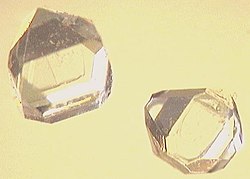Xylitol
 |
|
 Xylitol crystals
|
|
| Names | |
|---|---|
|
Systematic IUPAC name
(2R,3r,4S)-Pentane-1,2,3,4,5-pentol
|
|
| Other names
(2R,3r,4S)-Pentane-1,2,3,4,5-pentaol (not recommended)
1,2,3,4,5-Pentahydroxypentane Xylite |
|
| Identifiers | |
|
87-99-0 |
|
| 3D model (Jmol) | Interactive image |
| ChEMBL |
ChEMBL96783 |
| ChemSpider |
6646 |
| ECHA InfoCard | 100.001.626 |
| E number | E967 (glazing agents, ...) |
| PubChem | 6912 |
| UNII |
VCQ006KQ1E |
|
|
|
|
| Properties | |
| C5H12O5 | |
| Molar mass | 152.15 g·mol−1 |
| Density | 1.52 g/cm3 |
| Melting point | 92 to 96 °C (198 to 205 °F; 365 to 369 K) |
| Boiling point | 345.39 °C (653.70 °F; 618.54 K) Predicted value using Adapted Stein & Brown method |
| ~ 0.1 g/mL | |
| Hazards | |
| NFPA 704 | |
| Related compounds | |
|
Related alkanes
|
Pentane |
|
Except where otherwise noted, data are given for materials in their standard state (at 25 °C [77 °F], 100 kPa).
|
|
|
|
|
| Infobox references | |
Xylitol /ˈzaɪlᵻtɒl/ is a sugar alcohol used as a sweetener. The name derives from Greek: ξύλον, xyl[on], "wood" + suffix -itol, used to denote sugar alcohols. Xylitol is categorized as a polyalcohol or sugar alcohol (alditol). It has the formula CH2OH(CHOH)3CH2OH and is an achiralisomer of pentane-1,2,3,4,5-pentol. Unlike other natural or synthetic sweeteners, xylitol is actively beneficial for dental health by reducing caries (cavities) to a third in regular use and helpful to remineralization. Multiple studies utilizing electron microscopy have indicated that xylitol is effective in inducing remineralization of deeper layers of demineralized enamel. Fair evidence was found that xylitol (as chewing gum, lozenges, nasal spray, etc.) reduced the incidence of acute middle ear infection in healthy children.
Xylitol is naturally found in low concentrations in the fibers of many fruits and vegetables, and can be extracted from various berries, oats, and mushrooms, as well as fibrous material such as corn husks and sugar cane bagasse. However, industrial production starts from xylan (a hemicellulose) extracted from hardwoods or corncobs, which is hydrolyzed into xylose and catalytically hydrogenated into xylitol. A study in laboratory rats that compared xylitol to other artificial sweeteners found that xylitol had fewer or no side effects, had fewer calories, and was less likely to cause cavities (that is, had lower cariogenicity) than sucrose (table sugar).
...
Wikipedia

